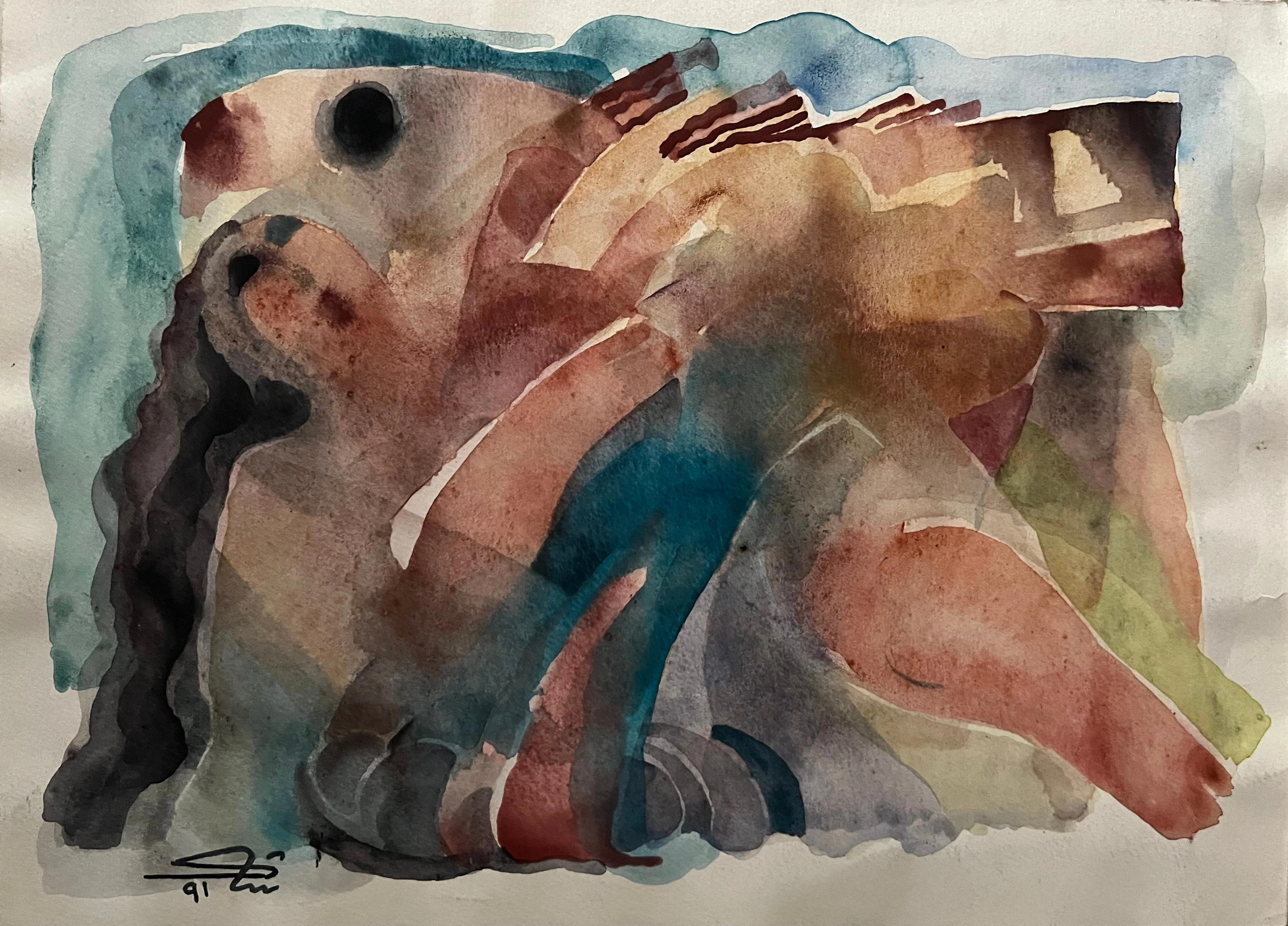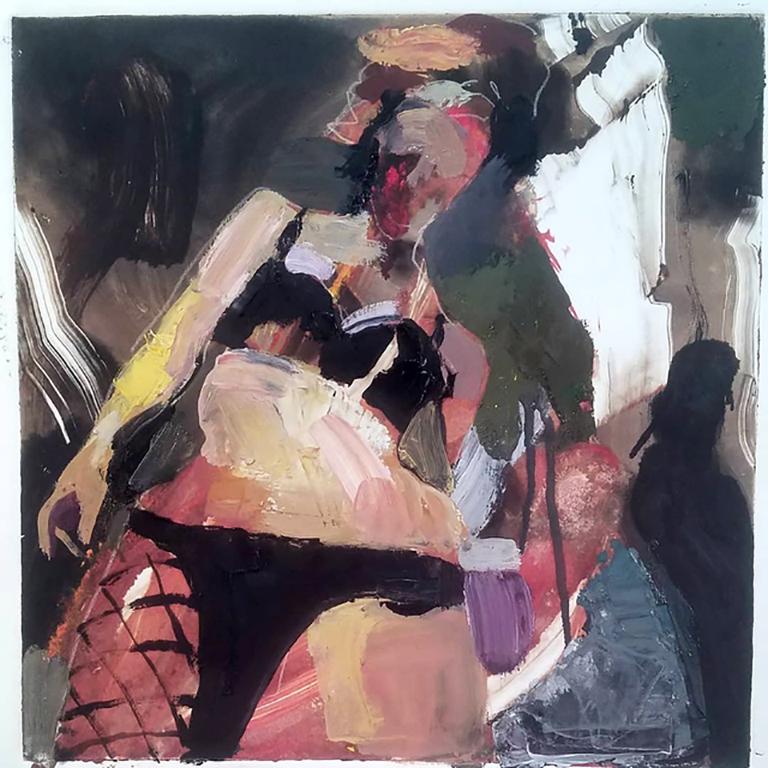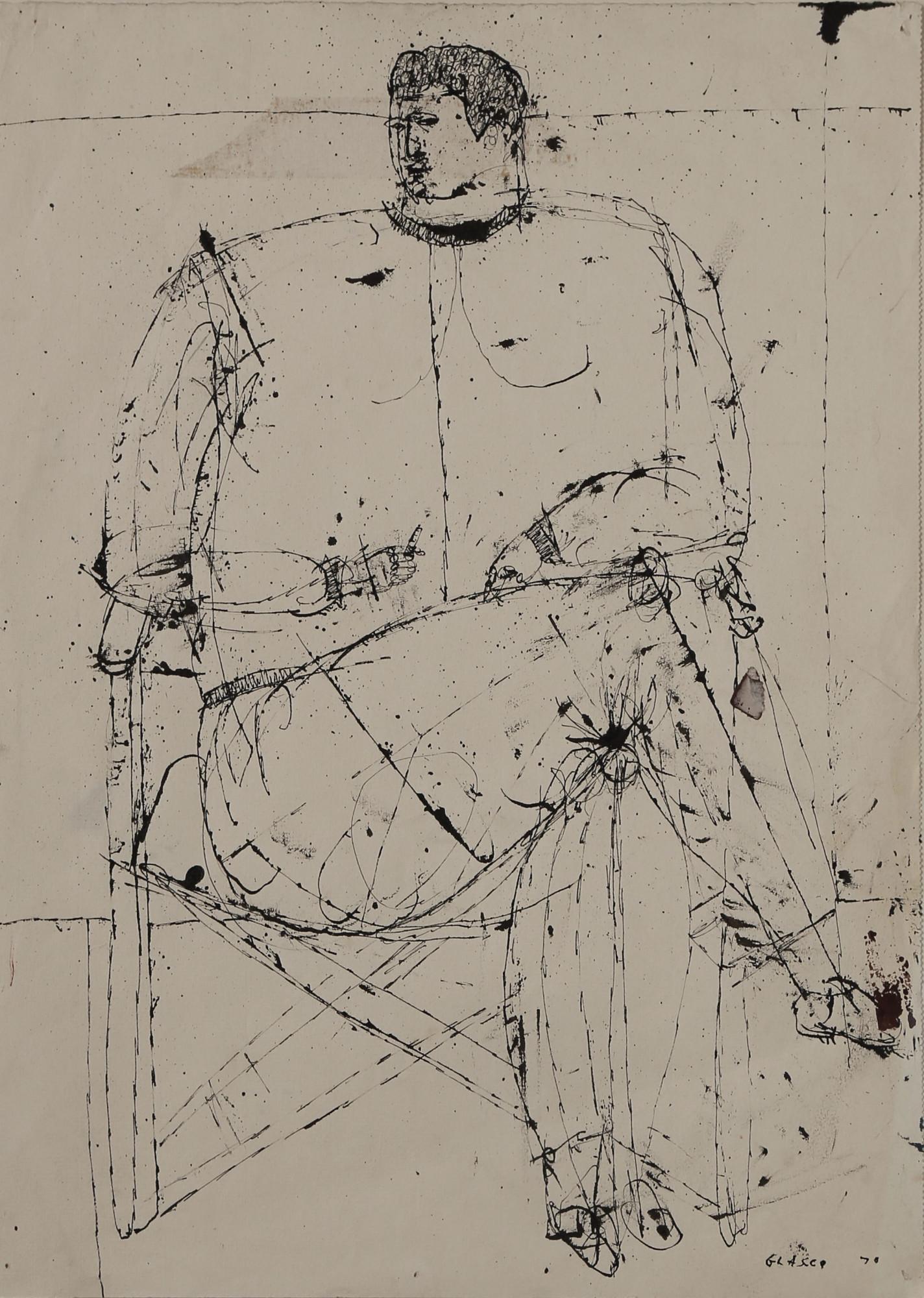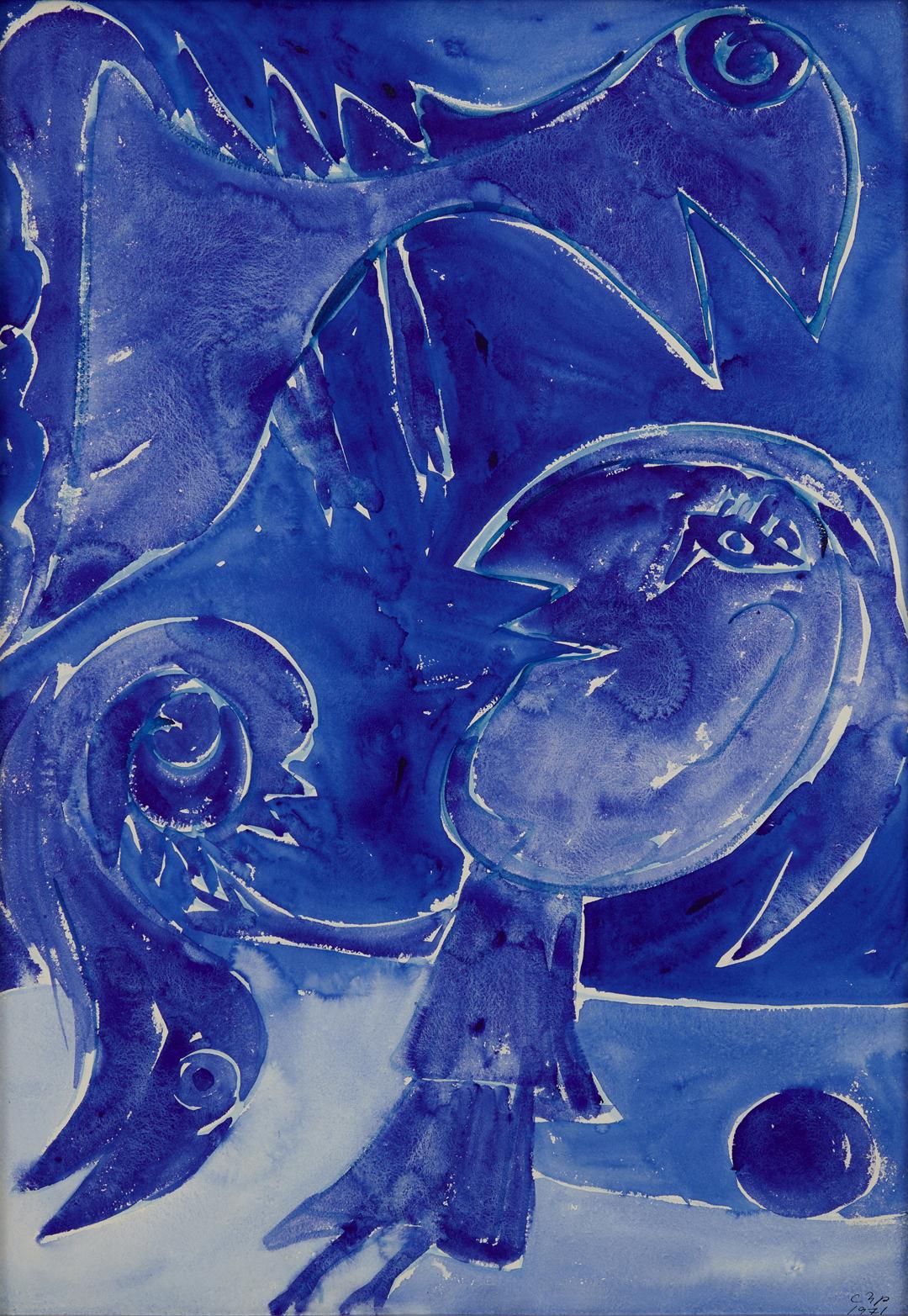Items Similar to Abstract Expressionist CoBrA Style Figure. Chalk on Card.
Want more images or videos?
Request additional images or videos from the seller
1 of 14
Abstract Expressionist CoBrA Style Figure. Chalk on Card.1970s
1970s
About the Item
Abstract expressionist CoBrA style chalk on paper of a human figure attributed to French artist, A Nuchy. The work is unsigned but was acquired along with other works signed by the artist and also available on 1st Dibs.
Highly colourful and inventive this chalk on paper exemplifies the total freedom of expression embraced by the CoBrA style.
Simple, bold , naiive, experimental and almost childlike in its execution. These are the qualities which bring exciting colour, form and a sense of freedom and joy to CoBrA paintings and this fine example.
COBRA (or CoBrA) was a European avant-garde movement active from 1948 to 1951. The name was coined in 1948 by Christian Dotremont from the initials of the members' home countries' capital cities: Copenhagen (Co), Brussels (Br), Amsterdam (A).
During the time of occupation of World War II, the Netherlands had been disconnected from the art world beyond its borders. COBRA was formed shortly thereafter. This international movement of artists who worked experimentally evolved from the criticisms of Western society and a common desire to break away from existing art movements, including "detested" naturalism and "sterile" abstraction. Experimentation was the symbol of an unfettered freedom, which, according to Constant, was ultimately embodied by children and the expressions of children. COBRA was formed by Karel Appel, Constant, Corneille, Christian Dotremont, Asger Jorn, and Joseph Noiret on 8 November 1948 in the Café Notre-Dame, Paris, with the signing of a manifesto, "La cause était entendue" ("The Case Was Settled"), drawn up by Dotremont. Formed with a unifying doctrine of complete freedom of colour and form, as well as antipathy towards Surrealism, the artists also shared an interest in Marxism as well as modernism.
Their working method was based on spontaneity and experiment, and they drew their inspiration in particular from children’s drawings, from primitive art forms and from the work of Paul Klee and Joan Miró. Interestingly a large influence on this movement's style was the discovery and opening of the Lascaux caves in the Dordogne region of France 10 years before the group formed.. The freely expressive primitive cave paintings were inspirational, offering a childlike naiivety and total freedom of expression which the CoBrA members fully embraced. The CoBrA movement although short lived ( only 1948-51 ) went on to have enormous impact in the artworld over the decades and into the present day.
- Attributed to:A Nuchy
- Creation Year:1970s
- Dimensions:Height: 29.41 in (74.7 cm)Width: 20.36 in (51.7 cm)Depth: 0.08 in (2 mm)
- Medium:
- Movement & Style:
- Period:
- Condition:The image itself is in good condition however there has been some water damage (now dry) to the bottom left corner which is not immediately noticeable and would not be visible once framed.
- Gallery Location:Cotignac, FR
- Reference Number:
About the Seller
5.0
Platinum Seller
These expertly vetted sellers are 1stDibs' most experienced sellers and are rated highest by our customers.
Established in 2000
1stDibs seller since 2020
153 sales on 1stDibs
Typical response time: <1 hour
- ShippingRetrieving quote...Ships From: Cotignac, France
- Return PolicyA return for this item may be initiated within 3 days of delivery.
More From This SellerView All
- Mother Nature, Lyrical Surrealist Abstract Watercolour on Paper.Located in Cotignac, FRMid-century lyrical surrealist abstract watercolour on paper by French artist Jean Clerté, signed and dated bottom right. Presented in mid-century frame. Jean Clerté , born in 1930 in Saint-Savin-sur-Gartempe in Vienne, is a French painter, engraver, draftsman, watercolourist and sculptor . This work is a great example of his more humorous and expressive work influenced by Alechinsky from the late 1960s onwards. There is a light playfulness and yet the watercolours are more vivid than his previous palette. Jean Clerté works in series. His sequential narrations testify both to a youthful spontaneity and to a perfect mastery in the distribution of forms and images on the painted surface. The narration is not only an accumulation of juxtaposed fragments and symbols, it forms a whole, it takes on and gives meaning. In general, we can say of Clerté that he practices an “eco-art” that feeds on primary hungers: the feeling of being united with nature, the vegetable, the mineral, the aquatic. In his colourful canvases, his inks, his boxes, his objects, like a shaman on the path of his dreams, the painter Clerté mounts an assault on beasts and demons, elves and gnomes. From the Poitevin marshes to the tropical forests emerges a fauna caught in the meanders of a design that marvels at the appearance of these grotesque idols. Jean Clerté began to draw and paint at a very young age, and at the age of 15 he enrolled at the École des Beaux-Arts in Poitiers. Then in 1949, curious about the capital, he moved to Paris. Having very few financial resources, he could not continue his studies at first, worked as a model to survive, and met other artists; he was then admitted to the studio of Ossip Zadkine and, from 1952, he was also able to study engraving at Atelier 17 of Stanley William Hayter, an English engraver and printer living in Paris associated in the 1930s with surrealism. At the end of the 1960s, he worked alongside Pierre Alechinsky, founding member of the Cobra movement, engraving Alechinsky's originals, benefiting from his advice, and discovering acrylic as a medium. From 1976, Jean Clerté became associate professor at Hayter. Clerté had taught previously, in 1971 at the Salzburg Summer University and in 1972 he gave courses at the Paris-Sorbonne University . In 1981, he was appointed professor at the School of Decorative Arts , where he had Maïlys Seydoux-Dumas as a student and, from 1983 to 1988, he was Alechinsky's assistant professor at the Paris School of Fine Arts. His first works are part of the current of lyrical abstraction, and are nourished by impressions of nature (landscape motifs, e.g. forest fires, waterscapes), then around 1968, encouraged by Alechinsky, he rejects abstraction, and his work becomes more figurative with expressive and humorous elements. From this period his colours are more subdued, often with pastel tones, he works on series. Jean Clerté has created a world in a space where drawing, painting, objects participate in a playful figuration. From his drawings were born sculptures and sometimes mobiles (Le Moulin à dessin). If it is the artist who makes astonishing, polychrome, whimsical “toys”, it is the painter who appeals to adults through his caustic and satirical humour. His first exhibitions in France took place at the Galerie Massol , then at the Galerie Pascal...Category
Mid-20th Century Surrealist Figurative Drawings and Watercolors
MaterialsPaper, Watercolor
- Abstract Expressionist CoBrA Style Anthropomorphic Bird. Chalk on Paper.Located in Cotignac, FRAbstract expressionist CoBrA style chalk on paper of an imaginary bird by French artist, A Nuchy. Signed to the bottom right. Highly colourful and inventi...Category
1970s Abstract Expressionist Animal Drawings and Watercolors
MaterialsPaper, Chalk
- Napoleon at the Head of His Grande Armée, His Generals and the Prussian HussarsLocated in Cotignac, FRPencil, chalk and watercolour depiction of Napoleon at the head of his generals by French artist Jean Ducel. The work is signed bottom right. A bold and graphic depiction of Napoleo...Category
Late 20th Century Romantic Figurative Drawings and Watercolors
MaterialsWatercolor, Chalk, Crayon, Cardboard, Pencil
- Abstract Expressionist Biomorphic Coloured Pencil Drawing.Located in Cotignac, FR1980s abstract expressionist biomorphic coloured pencil drawing on paper by Belgian artist André Pierret, signed bottom right. André Pierret was born ...Category
1980s Abstract Expressionist Abstract Drawings and Watercolors
MaterialsPaper, Carbon Pencil, Color Pencil
- The Artist In His Atelier, Mid Century, Ecole De NiceLocated in Cotignac, FRFrench Mid Century work on card by Sylvain Vigny. Depicting an artist (self portrait?) in his studio with his subject and muses, like Les Demoiselles d'Avignon. Reminiscent of the drawings of Picasso and Matisse who were his contemporaries and neighbours on the Cote D'Azur at this period. The painting is signed and dated bottom left. In period chrome edged frame, currently under glass. If Sylvain Vigny had stayed in Paris in 1934 instead of moving to Nice on the Côte d’Azur, his highly imaginative and original work might be better known. Comparisons with better-known modernist artists including Maurice de Vlaminck, Georges Rouault and Raoul Dufy set him in an appropriate and favourable context. A self-taught artist, he grew up in Vienna and emigrated to France in the 1920s, living in Paris from 1929 to 1934. After he had moved to Nice early in 1934, he exhibited in galleries along the Mediterranean coast and in Switzerland, with major exhibitions in New York in 1938 and at the Galerie Bernheim Jeune in Paris in 1948. Sylvain Vigny was part of an important artistic community in Nice, which included Jean Moulin who owned the Galerie d’Art Roman, the artist Jean Cassarini, writers Pierre and Jacques Prévert, filmmaker Nikos Papatakis, and jazz musician Django Reinhardt...Category
1950s Expressionist Figurative Drawings and Watercolors
MaterialsInk, Watercolor, Gouache, Cardboard
- Persephone, 19th Century Classical French Academy DrawingLocated in Cotignac, FR19th Century French Academy drawing of a classical maiden, signed Xavier Rendeley bottom right, numbered and dated 2nd April 1883. Presented in ...Category
1880s Academic Figurative Drawings and Watercolors
MaterialsPaper, Chalk, Pencil
You May Also Like
- double-sided marker drawing spanish abstract expressionismBy Ignacio Gil SalaLocated in Barcelona, BarcelonaOne side signed. Lower right corner slightly bent. Measures 29x20. Frameless. Ignacio Gil Sala, was a painter, bohemian character, adventurous and intrepid traveler who knew how to ...Category
1980s Abstract Expressionist Figurative Drawings and Watercolors
MaterialsPermanent Marker
- Good Friday, abstract female figureBy Tom BennettLocated in Brooklyn, NYOil on paper, signature Tom Bennett freedom of rich brushwork, warm colorsCategory
2010s Abstract Expressionist Figurative Drawings and Watercolors
MaterialsPaper, Oil
- Uniquely Unfit for Constraints, 40"x26" abstract gesture w female figureLocated in Brooklyn, NYRINY artists Audrey Anastasi and C.Dimitri collaborated to create contemporary collage works. Born of the Covid pandemic, the team started working remotely, mailing artwork to each ...Category
2010s Abstract Expressionist Figurative Drawings and Watercolors
MaterialsMixed Media, Acrylic, Archival Paper
- Seated Figure, 20th century figural abstract expressionist ink drawingBy Joseph GlascoLocated in Beachwood, OHJoseph Glasco (American, 1925-1996) Seated Figure 1970 India ink on paper 16 x 11.5 inches Signed and dated lower right Joseph Glasco was born in Paul’s Valley, Oklahoma and grew up...Category
1970s Abstract Expressionist Figurative Drawings and Watercolors
MaterialsIndia Ink
- The Blue Earth II, CoBrA movement, Mid-20th Century Danish WatercolorBy Carl-Henning PedersenLocated in Beachwood, OHCarl-Henning Pedersen (Denmark, 1913 - 2007) The Blue Earth II, 1971 Watercolor on paper Signed and dated lower right, signed, dated and titled verso 30.5 x 21.5 inches Carl-Hennin...Category
1970s Abstract Expressionist Figurative Drawings and Watercolors
MaterialsWatercolor
- Mercedes Matter, New York School Abstract FiguresBy Mercedes MatterLocated in New York, NYMercedes Carles Matter (1913 - 2001) Untitled, circa 1937 Pastel on paper 16 x 13 1/2 inches Estate stamped on the reverse Provenance: Estate of the artist Spanierman Gallery, New York Private Collection, Pennsylvania circa 2013 Private Collection, New York, 2021 Mercedes Matter was born in New York in 1913. Her father, the American modernist Arthur B. Carles, had studied with Matisse. Her mother, Mercedes de Cordoba, was a model for Edward Steichen. Ms. Matter grew up in Philadelphia, New York and Europe. She began painting under her father's supervision at age 6, and studied art at Bennett College in Millbrook, N.Y., and then in New York City with Maurice Sterne, Alexander Archipenko and Hans Hofmann. In the late 1930's, she was an original member of the American Abstract Artists organization and worked for the federal Works Progress Administration, assisting Fernand Léger on his mural for the French Line passenger ship company. Léger introduced her to Herbert Matter, the Swiss graphic designer and photographer, whom she married in 1939. The Matters were active in the emerging New York art scene and also traveled frequently to Europe. Their closest friends included Jackson Pollock, Lee Krasner, Franz Kline, Philip Guston, Alexander Calder and Willem de Kooning. They were also close to Alberto Giacometti, who was an important artistic role model for Mrs. Matter and a frequent photographic subject for her husband. Beginning in 1953, Mrs. Matter taught at the Philadelphia College of Art (now University of the Arts), Pratt Institute and New York University. Based on her teaching experiences she wrote an article for Art News in 1963 titled ''What's Wrong with U.S. Art Schools?'' In it, she lamented the phasing out of the extended studio classes required to initiate ''that painfully slow education of the senses,'' which she considered an artist's life work. The article prompted a group of Pratt students to ask her to form a school based on her ideas, which led, in 1964, to the founding of the New York Studio School. Originally in a loft on Broadway, the school gained almost immediate support from the Kaplan Fund, the Rockefeller Brothers Fund and the Ford Foundation. It granted no degrees, had only studio classes and emphasized drawing from life. Its teachers, chosen by the students, included the artists Guston, Bradley Walker Tomlin, Charles Cajori, Louis Finkelstein...Category
1930s Abstract Expressionist Figurative Drawings and Watercolors
MaterialsOil Pastel, Paper, Pastel



